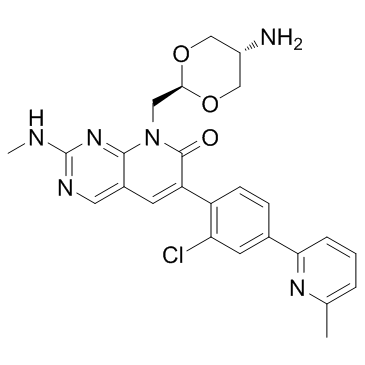1648863-90-4
| Name | G-5555 |
|---|---|
| Synonyms |
8-[(trans-5-Amino-1,3-dioxan-2-yl)methyl]-6-[2-chloro-4-(6-methyl-2-pyridinyl)phenyl]-2-(methylamino)pyrido[2,3-d]pyrimidin-7(8H)-one
Pyrido[2,3-d]pyrimidin-7(8H)-one, 8-[(trans-5-amino-1,3-dioxan-2-yl)methyl]-6-[2-chloro-4-(6-methyl-2-pyridinyl)phenyl]-2-(methylamino)- 8-[(Trans-5-Amino-1,3-Dioxan-2-Yl)methyl]-6-[2-Chloro-4-(6-Methylpyridin-2-Yl)phenyl]-2-(Methylamino)pyrido[2,3-D]pyrimidin-7(8h)-One |
| Description | G-5555 is a potent p21-activated kinase 1 (PAK1) inhibitor with Kis of 3.7 nM and 11 nM for PAK1 and PAK2, respectively. |
|---|---|
| Related Catalog | |
| Target |
PAK1:3.7 nM (Ki) PAK2:11 nM (Ki) |
| In Vitro | G-5555 is a potent PAK1 inhibitor with a Ki of 3.7 nM. G-5555 shows excellent kinase selectivity and inhibits only eight out of the 235 kinases tested other than PAK1 with inhibition >70%: PAK2, PAK3, KHS1, Lck, MST3, MST4, SIK2, and YSK1. The IC50s of G-5555 against SIK2, PAK2, KHS1, MST4, YSK1, MST3 and Lck are 9, 11, 10, 20, 34, 43, 52 nM, respectively. In general, G-5555 demonstrates high selectivity for the group I PAKs. There is negligible activity for G-5555 against the hERG channel with IC50 more than 10 μM in a patch clamp assay[1]. G-5555 potently inhibits PAK2, with a Ki of 11 nM. In an array of 23 breast cancer cell lines, G-5555 has significantly greater growth inhibitory activity in cell lines that are PAK-amplified compared to non-amplified lines[2]. |
| In Vivo | G-5555 exhibits low blood clearance and an acceptable half-life. Good oral exposure (AUC = 30 μM•h) and high oral bioavailability (F = 80%) are achieved[1]. In an H292 non-small cell lunger cancer (NSCLC) xenograft study in mice, G-5555 inhibits phosphorylation of the PAK1/2 downstream substrate mitogen-activated protein kinase 1 (MEK1) S298 and, when administered at an oral dose of 25 mg/kg b.i.d., imparts 60% tumor growth inhibition in this model13 and a PAK1 amplified breast cancer xenograft model, MDAMB-175[2]. |
| Kinase Assay | The 10 µL assay mixtures contain 50 mM HEPES (pH 7.5), 0.01% Brij-35, 10 mM MgCl2, 1 mM EGTA, 2 µM FRET peptide substrate, and PAK enzyme (20 pM PAK1; 50 pM PAK2; 90 pM PAK4). Incubations are carried out at 22°C in black polypropylene 384-well plates. Prior to the assay, enzyme, FRET peptide substrate and serially diluted test compounds (G-5555, etc.) are preincubated together in assay buffer (7.5 µL) for 10 minutes, and the assay is initiated by the addition of 2.5 µL assay buffer containing 4× ATP (160 µM PAK1; 480 µM PAK2; 16 µM PAK4). Following the 60-minute incubation, the assay mixtures are quenched by the addition of development reagent, and 1 hour later the emissions of Coumarin (445 nm) and Fluorescein (520 nm) are determined after excitation at 400 nm[1]. |
| Animal Admin | Mice[1] Three mice in each of the two groups are administered 25 mg/kg oral suspension dose twice, with the second dose given 6 hours after the first dose. The dose volumes are 5 mL/kg for the IV group and 10 mL/kg for the PO groups. Following administration of G-5555, 15 µL of blood is collected at each time point are stored at -70 to -80°C until analysis[1]. |
| References |
| Density | 1.4±0.1 g/cm3 |
|---|---|
| Boiling Point | 684.6±65.0 °C at 760 mmHg |
| Molecular Formula | C25H25ClN6O3 |
| Molecular Weight | 492.957 |
| Flash Point | 367.8±34.3 °C |
| Exact Mass | 492.167664 |
| LogP | 1.98 |
| Vapour Pressure | 0.0±2.1 mmHg at 25°C |
| Index of Refraction | 1.652 |
| Storage condition | 2-8℃ |
